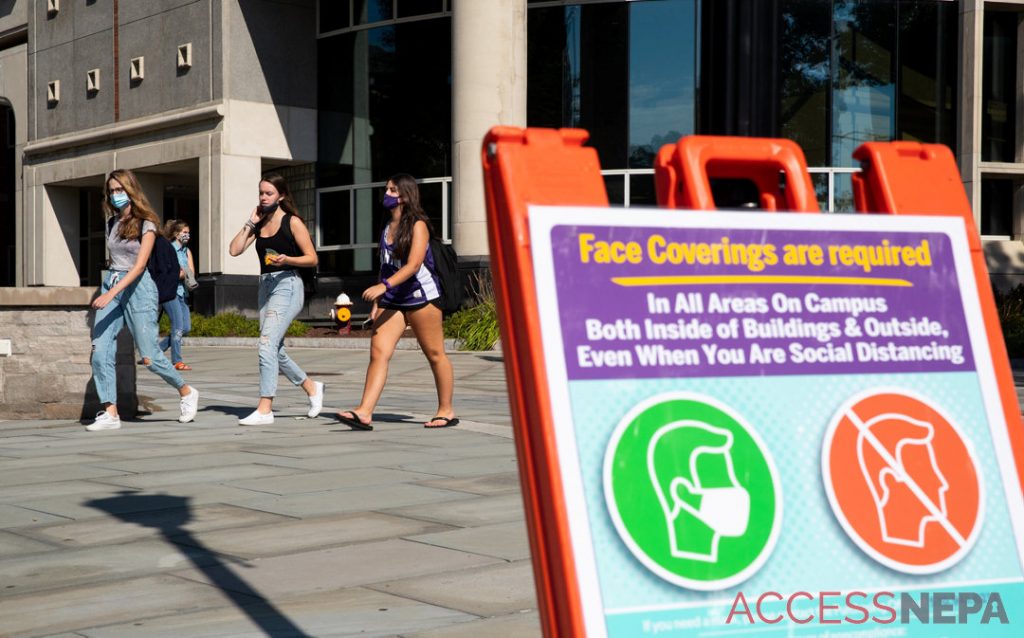Kevin Pepsin didn’t expect his freshman year of college to consist of Zoom meetings with professors and little social interaction with his classmates.
The Old Forge graduate, who hopes to become a state trooper, received an honors scholarship to attend Lackawanna College. Like other schools in the region, the college offers a mix of in-person and online courses this semester.
“It really makes everything easier right now, with all the uncertainty going on in the world,” Pepsin said. “It would be a waste to go away to a school and then be shut down and still pay all that money. … This is a better decision right now.”
Many of his peers agree. The college set an enrollment record for the fall, with 1,888 students across its seven locations.
“Students are looking at long-term debt, affordability and return on investment,” said Jill Murray, Ph.D., college president. “That is a very big consideration for families during this awful economic time and global pandemic.”
The coronavirus pandemic continues to alter the student experience on campuses across Northeast Pennsylvania and beyond. While Lackawanna College and Johnson College experience record enrollments with students opting to stay close to home, other schools have experienced declines.
University of Scranton ballrooms that held 200 people now have desks for 30 students.
Many Marywood University students live without roommates.
Penn State Scranton replaced large cafeteria tables with individual student desks for dining.
Professors teach many classes remotely, while schools balance trying to keep students and staff safe with providing a traditional college experience.
“It’s been a lesson learned for all of us,” Murray said. “We’re so fortunate in this region to have so many great institutions of higher education.”
Making adjustments
After the sudden closure of schools in March, the colleges shifted to online instruction and began determining how to bring students back safely.
Nationwide, undergraduate enrollment decreased 2.5% compared to last fall, according to preliminary data from the National Student Clearinghouse Research Center.
Undergraduate enrollment decreased 3.5% at the University of Scranton, while graduate level enrollment decreased by 11% compared to last fall. Total enrollment is 4,957 for this fall.
With an aggressive coronavirus testing policy, the university has reported 379 positive tests for the virus since students returned in August – far more than other colleges in the region. The school held all classes remotely for two weeks last month to slow the virus’s spread.
On campus last week, students ate lunch behind plexiglass barriers. Physics students sat in a partitioned ballroom in the DeNaples Center. Signs instructed students to stay apart, wear their masks and sanitize their hands.
Junior exercise science major Eleanor Lindauer sat in the science building, one of the only people in a lounge area that would usually be busy with students. A member of the field hockey team who hopes to play in the spring, Lindauer said this semester has been a big adjustment.
“It takes away from the group atmosphere we came to college for,” she said.
With many online courses that also offer once-weekly in-person meetings, she sees fewer students on campus.
“I miss the social atmosphere,” she said. “Hopefully, it gets back to normal soon.”

ACCESS NEPA FILE
University of Scranton students don masks as they walk across campus earlier in the fall 2020 semester.
College enrollments
Nationwide, many students opted to transfer to schools closer to home due to uncertainties and possible shutdowns due to the coronavirus.
Keystone College saw a 1.6% increase in enrollment, to 1,386 students, mainly due to an influx of transfer and nontraditional students. Although freshmen enrollment declined from 340 to 227 students, the college still met many of its enrollment goals, according to Fran Calpin, college spokesman.
And like other schools, the pandemic has added stress to the college’s finances. Keystone reduced the number of beds on campus from 510 to 450 to provide additional single-occupancy rooms and separate spaces for quarantine and isolation.
Among other Lackawanna County schools:
- Penn State Scranton also saw an increase in enrollment this year. The 5.4% increase, to 1,010 students, can be attributed to several factors, including the nursing program, recruitment and retention efforts and some students staying close to home due to the pandemic, spokeswoman Amy Gruzesky said.
- About one-third of Clarks Summit University’s enrollment is on-campus, undergraduate students. That category increased from 292 to 298 students, spokeswoman Dena Cambra said. The majority of the school’s students, who study online in both undergraduate and graduate programs, make up the other two-thirds of the student body. Having a smaller on-campus population has contributed to being able to promote safety measures, she said.
- Luzerne County Community College, which operates a center at the Marketplace at Steamtown, saw students at the center decline from 200 to 121 in the last year. The college now offers more courses online, spokeswoman Lisa Nelson said.
- Geisinger Commonwealth School of Medicine’s enrollment in the medical degree program remains steady at 450 students. Master’s degree enrollment increased from 97 to 124.
- Johnson College experienced record enrollment this fall. The enrollment of 497 students is an increase of 5% over last year. Of the freshman, 27% transferred in from another institution, according to the college.

CHRISTOPHER DOLAN / STAFF PHOTOGRAPHER
Penn State Scranton student Deymeliz Desarden-Ruperto of Throop sits in the college’s socially distant cafeteria on Oct. 8, 2020.
Safe interaction
At Marywood, preparing for the fall meant bringing students together while also keeping them apart. Large white tents provide outdoor space for students to learn in fresh air. Crews installed plexiglass, removed desks and distributed masks and hand sanitizer throughout campus.
“We’ve reduced the critical mass of students on campus at any one time by saying that your classes are all online but there’s one time a week where you have to come. We’re calling it enrichment,” explained Sister Mary Persico, I.H.M., Ed.D., university president.
That enrichment time can include a small group lesson or lab.
Marywood saw its undergraduate enrollment decline by only six, to 1,810 students. A greater number of students are from within a 50-mile radius, compared to previous years, said Ann Boland-Chase, vice president for enrollment services and student success.
Graduate school enrollment decreased by 11%, to 805 students, this fall. Some students felt unsure about taking graduate-level courses due to uncertainties with their own jobs, Chase said. For example, graduate students who are teachers in area schools opted to take a semester off to focus on the move to online and hybrid schedules, she said.
“Generally we’re pleased compared to what some places have experienced across the U.S.,” she said. “I give students a lot of credit for persevering and staying the course.”
Kathleen Bolus, staff writer, contributed to this report.

Sarah balances life as a reporter for The Times-Tribune and as the mom of two little girls. A graduate of Ithaca College, Sarah started covering education in 2006. She has received awards for her reporting from the Society of Professional Journalists, Pennsylvania Newsmedia Association, Inland Press Association and Pennsylvania Women’s Press Association. She lives in Clarks Summit with her husband, their daughters and their sweet pug, Sadie. Reach her at shofius@timesshamrock.com, 570-348-9133 or @HofiusHallTT.




